Ijraset Journal For Research in Applied Science and Engineering Technology
- Home / Ijraset
- On This Page
- Abstract
- Introduction
- Conclusion
- References
- Copyright
AgriSolutions: Innovations in Crop Disease Prediction, Crop Recommendation, and E Commerce
Authors: Kshitij Ghuge, Jagannath Mestry, Abhishek Palav, Pranit Temkar, Seema Ladhe, Manisha Patil
DOI Link: https://doi.org/10.22214/ijraset.2024.61302
Certificate: View Certificate
Abstract
Crop disease prediction and crop recommendation are important steps towards sustainable agriculture. The use of deep learning, EfficientNet_v2 and image processing technologies can help in improve accuracy in these tasks. Identification of plant diseases and recommendation of crops cannot maximize only yield production but can be supportive for varied types of agricultural practices The existing system of crop recommendation employs data analysis to suggest suitable crops based on soil and climate factors, while disease prediction system utilizes predictive models to anticipate and prevent crop diseases. In this Paper, we propose a model that combines these techniques to accurately identify to recommend suitable crops based on the Soil Parameters and climate conditions of the farm. Our proposed model achieved and classify plant diseases, recommend suitable crops based on the soil condition. To achieve this, we trained a deep neural network on a large dataset of images of healthy and diseased plants, and performed image preprocessing. We then used the Random Forest algorithm to achieve high accuracy in disease prediction, crop recommendation and can be used as a tool for precision agriculture. An ECommerce auction platform is designed for farmers, enabling them to directly sell their crops at fixed rates to interested buyers. In addition to this, using our proposed model an auction system has also been incorporated, where retailers can bid and purchase crops from farmers. This system aims to facilitate the farming community by maximizing their profits and eliminating intermediaries between the farmers and the buyers. The platform would be accessible to farmers and retailers alike, ensuring a transparent and direct exchange of crops. This would not only be beneficial to the farmers by providing better prices but also ensure that retailers receive high-quality goods. The proposed e-commerce model has the potential to revolutionize agriculture and bring long-term benefits to farmers and retailers. We analyse our proposed model using the performance metrics accuracy and data loss.
Introduction
I. INTRODUCTION
Agriculture plays an important role in the development of the economy of a country. Diseases are a major threat to the crops. Diseases destroy the crop and thus reduce the yield and also the quality of the crops thereby decreasing the profits. The use of technology in the area of agriculture will reduce manual labour and increase the accuracy by decreasing the amount of error. The systems developed earlier have just been able to detect diseases of leaves. Using existing systems/models of agriculture it's difficult to identify which crops to grow. It is crucial to acknowledge the limitations of existing agricultural technologies. Many current systems lack thorough discussions on data representativeness, scalability, and real-world applicability. Recognizing these drawbacks highlights the need for further research to enhance the effectiveness and practicality of agricultural technologies. However, our proposed system will use image processing and classifiers which include CNN architecture [7] available for image classification to detect the diseases. Using our proposed model a crop will be selected considering land with site-specific parameters (i.e. soil specific parameters) with high accuracy and efficiency. The traditional process related to agriculture consumes significant time that can deteriorate quality while the farmer has no return of investment. In order to overcome these issues, an E-Commerce solution of our proposed model can be used which can be transparent enough to make sure that farmer gets the return of investment with profits and is used without a middleman (broker) to sell the yield. Smart agriculture tools enable precision farming practices, such as Crop disease prediction and recommendation. Our proposed E- commerce platforms can incorporate these practices by allowing farmers to specify the exact needs and conditions of their crops, resulting in more accurate product recommendations and targeted marketing.
Section I provides an introduction to the concept of Smart Agriculture and E-commerce highlighting current approaches and challenges faced by the farmers. Section II presents a comprehensive survey of existing literature. Sections III and IV explore the proposed methodologies of the system, substantiated by System Architecture and comprehensive procedural instructions.
Section V showcases the execution of our proposed model. Section VI provides a detailed analysis of the system's performance and its implications in crop disease detection, crop recommendation, and agricultural Ecommerce. Finally, Section VII summarizes the conclusions drawn from the research and outlines potential avenues for future exploration. As we move from the introduction, our exploration now shifts towards a concise review of existing literature, delving into the amalgamation of e-commerce platforms, smart agricultural tools, and disease detection technologies.
II. LITERATURE SURVEY
In this section we provide an extensive review of work related to Smart Agriculture and E-Commerce. The topic Agriculture has been a quite trending research area in the last decennial. Researchers have explored various solutions for disease prediction from crop data.
In [1], the author proposed a system that predicts and classifies more than 10 diseases. Leveraging Deep Convolutional Neural Networks and the ResNet50 algorithm, the proposed model attained an impressive accuracy rate of 99.24%. This highlights the robustness and efficacy of the utilized methodology in handling complex disease classification tasks. Furthermore, the high accuracy achieved underscores the potential of deep learning techniques in advancing disease diagnosis and management.
In [2], Sk Al Zaminur Rahman et.al., proposed a model capable of classifying and recommending crops based on land characteristics, soil compositions, and environmental factors. The model employs Weighted KNN, SVM, and Bagged Tree algorithms for soil classification and crop recommendation. This approach harnesses a combination of machine learning techniques to enhance accuracy and robustness in agricultural decision-making processes.
In [3], Jagadish Kashinath Kamble proposed a model for classifying and predicting various crop diseases. The author utilized image segmentation algorithms such as EMGM to extract features and patterns from crops. This innovative approach demonstrates the potential of image processing techniques in identifying and addressing crop diseases, contributing to more effective agricultural management practices.
In [4], Pranay Malik et al., proposed a system aimed at understanding soil properties and crop yield based on soil composition. Their work demonstrates the applicability of KNN, Naive Bayes, and Decision Tree models in establishing relationships between crops and various physical factors. The study predicts the yield of three crops – tomato, potato, and chilli – across alluvial soil, red soil, and black soil types. This research contributes valuable insights into agricultural practices by facilitating informed decision-making regarding crop selection and soil management strategies.
In [5], Manisha Bhende et al., introduced a platform designed to bridge the gap between farmers, retailers/merchants, and government entities. Their proposed system leverages K-nearest neighbour search for enhanced decision-making capabilities and utilizes the Haversine algorithm to verify latitude and longitude coordinates via GPS technology, facilitating the seamless exchange of crops. This innovative approach fosters collaboration and synergy among stakeholders in the agricultural ecosystem, thereby promoting efficiency and transparency in crop transactions.
In [6], Kirti Tyagi et al., developed a system for identifying various plant diseases using convolutional neural networks (CNN). The authors utilized the Fast.ai Python library for training and testing the model. Their proposed model can identify up to 16 diseases with an accuracy of 86.4%. This work demonstrates the potential of deep learning approaches in automating plant disease diagnosis, which could significantly beneficial to the agricultural practices by enabling timely and accurate disease detection. The research papers reviewed herein demonstrate notable advancements in agricultural technology; however, they often lack comprehensive discussions regarding potential limitations. Critical issues such as data representativeness, model scalability, and realworld applicability remain largely unaddressed within the literature. Moreover, concerns pertaining to the robustness of image segmentation algorithms are not thoroughly examined. These identified limitations underscore the necessity for further research endeavours aimed at comprehensive validation and refinement of the proposed systems to ensure their practical effectiveness and viability in diverse agricultural settings, as emphasized within the context of this research paper. In this paper we have proposed 2 models, one is for Smart Agriculture for Plant Disease Detection and Crop Recommendations and other is for Auction based System using E-Commerce. Our proposed models focus on data representativeness and scalability. In section III we present the methodology of our proposed models.
III. METHODOLOGY
In this section we presented the methodology of our proposed models. In this study, we utilize a dataset sourced from Kaggle to develop two models for crop disease prediction and crop recommendation. Key data areas include soil parameters, weather parameters, and soil characteristics. After preprocessing to handle missing data and outliers, machine learning algorithms including EfficientNet_v2 and Random Forest , are implemented for training and testing. The data is visualized using Matplotlib for enhanced understanding. This approach aims to improve agricultural decisionmaking processes through robust predictive models.
Below we discuss the data set, data preprocessing, training and testing and data visualization
A. Collection Of Dataset
The dataset used in this proposed model is sourced from Kaggle and is free to use. Our proposed model can be used for both, crop/plant disease prediction and crop recommendation.
Data Fields for Crop Recommendation are from Kaggle :
- N - ratio of Nitrogen content in soil
- P - ratio of Phosphorous content in soil
- K - ratio of Potassium content in soil
- temperature in degree Celsius
- humidity - relative humidity in %
- ph - ph value of the soil
- rainfall - rainfall in mm
B. Data Pre-Processing:
The Dataset obtained was in raw form and consisted of redundant data. Some data values were missing. For accurate prediction, the rows containing missing values and the outliers in the dataset were removed.
C. Training and Testing:
After pre-processing of the data, the machine learning algorithms-EfficientNet_v2, Random Forest were implemented on the dataset using Python and Jupyter. The classes- good, average and poor were converted to numerical form for the ease of prediction. EfficientNet_v2 are deep learning models specialized in analyzing visual data, utilizing convolutional layers to extract features and hierarchical structures for image recognition and classification tasks. Random Forest is a machine learning algorithm that builds multiple decision trees and merges their predictions to improve accuracy and reduce overfitting, making it effective for both classification and regression tasks.
D. Data Visualization:
Matplotlib, a Python library, was utilized for data visualization, with variables being appropriately transformed into numerical format as needed.
Figure 1 represents the distribution of Crop Images in the dataset .
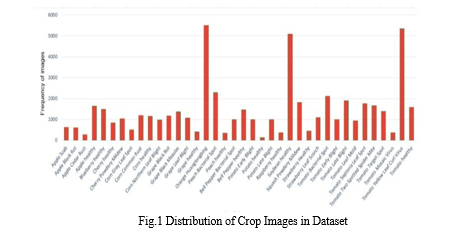
As we proceed to Section IV, 'Proposed Model,' we detailed the implementation of advanced technologies like EfficientNet_v2 and Random Forest in our Smart Agriculture project. Additionally, we have explored the development of an online marketplace platform, facilitating direct crop sales from farmers to end-users and retailers via an auction-based system.
IV. PROPOSED MODEL
The proposed system for the Smart Agriculture project using E-Commerce will leverage advanced technologies such as EfficientNet_v2 and Random Forest for predicting crop disease, recommending crops to farmers. In addition, we aim to build an online marketplace platform that will enable farmers to sell their crops directly to end-users and retailers through an auction-based system. Our proposed model aims to both Crop Disease Prediction and Crop Prediction and Recommendation.
A. Crop Disease Prediction:
The system will use EfficientNet_v2 to identify crop diseases based on analysis of plant symptoms. This helps in predicting crop disease for early prevention and quick treatment. Our proposed model can predict diseases of 11 crops.
B. Crop Prediction and Recommendation:
Our system will be trained on large datasets of agricultural data, machine learning algorithms. This will enable it to predict and recommend different crop. This system can assist farmers in making an informed decision regarding which crops to cultivate and when to do so.
In Figure 2 we have presented our proposed integrated system framework for Smart Agriculture.
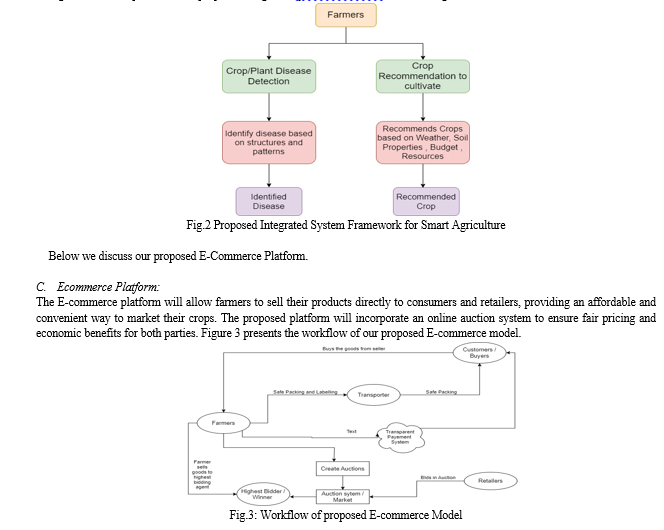
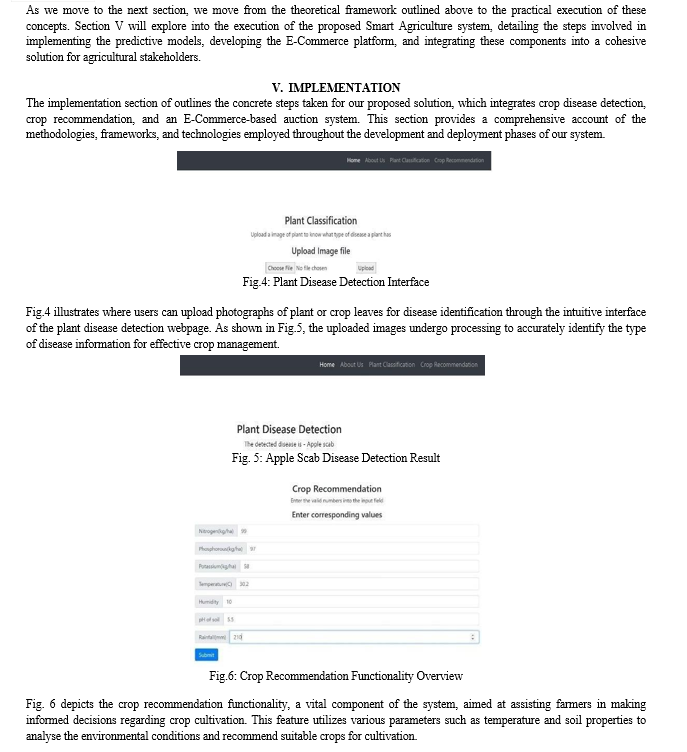
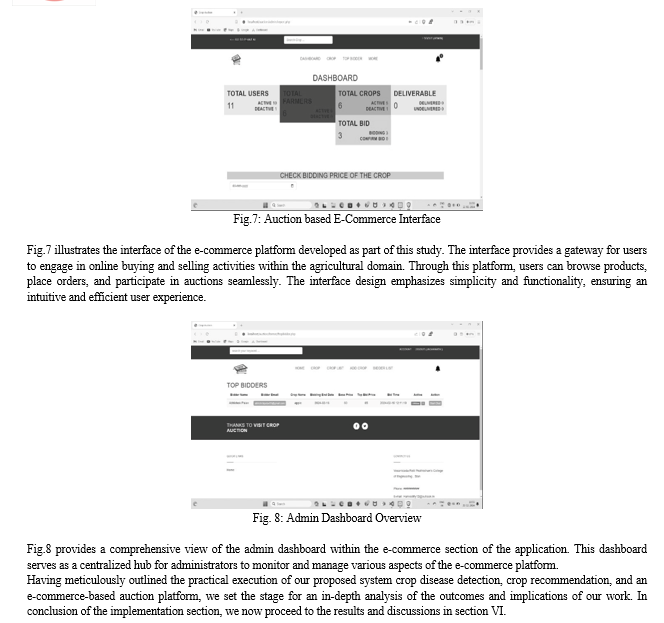
VI. RESULTS AND DISCUSSIONS
In the results and discussion section, we provide a detailed examination of the outcomes derived from the implementation and evaluation of our proposed system. This section presents an analysis of the system's performance, discussing its effectiveness in addressing the objectives outlined in the research. The major two performance matrices used are accuracy and data loss. By accuracy we mean that in the context of the project, accuracy refers to the measure of how effectively the proposed model can correctly identify plant diseases and recommend suitable crops based on soil parameters and climate conditions. By Overfitting We mean that in the context of the project, overfitting occurs when the proposed model learns to perform exceptionally well on the training dataset but fails to generalize effectively to unseen data.
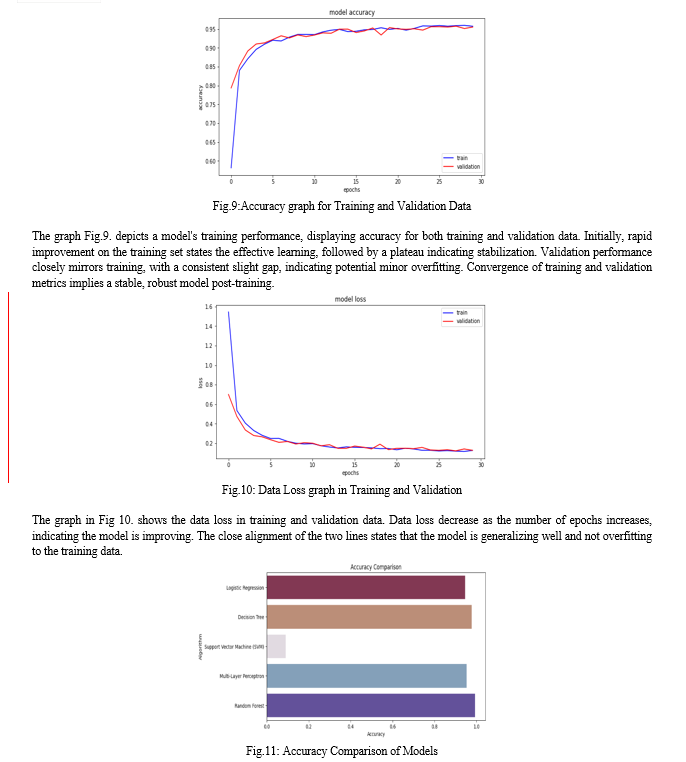
Figure 11 shows the accuracy of our proposed system using various algorithms like Logistic Regression, Decision Tree, Support Vector Machine, Multilayer Perception and Random Forest. From Figure 11 we conclude that the our propose system gives highest accuracy using Random Forest algorithm as compared to others.
With the results and discussions section offering a thorough analysis of our system's performance and implications, we now proceed to the conclusion. In this final segment, we will summarize the key findings, discuss their broader significance, and suggest potential directions for future research and application.
Conclusion
In this paper we have proposed two models; one is for Plant Disease Detection and Crop Recommendations and other is for Auction based System using ECommerce. We have analysed our proposed models using the performance metrices as accuracy and data loss. In existing systems, the issues like data representativeness, model scalability, and real-world applicability remain unaddressed. we conclude that the integration of deep learning, EfficientNet_v2, and image processing technologies presents a promising approach for advancing crop disease prediction and crop recommendation systems in agriculture. By combining these techniques, we have developed a model that accurately identifies and classifies plant diseases while recommending suitable crops based on soil conditions and climate factors. Our proposed model represents a significant step towards achieving sustainable and efficient agricultural practices through precision farming. The E-commerce platform further enhances the benefits offered to farmers and retailers by providing a direct marketplace for crop transactions, thereby maximizing profits and eliminating intermediaries. Additionally, the incorporation of smart agriculture tools enables precision farming practices, contributing to increased productivity and profitability. The major obstacle faced is the adoption of e-commerce platforms in agriculture may face barriers such as technological literacy, infrastructure limitations, and internet connectivity issues in rural areas. Despite these challenges, there is significant future scope for research and development in agricultural technologies
References
[1] Vishal Pallagani, Vedant Khandelwal, Vedant Khandelwal, Venkanna Udutalapally, Saraju P Mohanty, Debanjan Das “dCrop: A DeepLearning based Framework for Accurate Prediction of Diseases of Crops in Smart Agriculture” IEEE International Symposium on Smart Electronic Systems (iSES) 2019. [2] Sk Al ZaminurRahman, Kaushik Chandra Mitra, S.M. Mohidul Islam “Soil Classification using Machine Learning Methods and Crop Suggestion Based on Soil Series” 21st International Conference of Computer and InformationTechnology 2018. [3] Jagadish Kashinath Kamble “PLANT DISEASE DETECTOR” International Conference on Advances in Communication and Computing Technology (ICACCT) 2018. [4] Pranay Malik, Sushmita Sengupta, Jitendra Singh Jadon “Comparative Analysis of Soil Properties to Predict Fertility and Crop Yield using Machine Learning Algorithms” 11th International Conference on Cloud Computing, Data Science & Engineering Confluence 2021. [5] Mrs. Manisha Bhende, Ms. Mohini S. Avatad, Mrs. Suvarna Patil, Mrs. Pooja Mishra, Ms. PoojaPrasad, Mr. Shubham Shewalkar “Digital Market: E-Commerce Application for Farmers” Fourth International Conference on ComputingCommunication Control and Automation (ICCUBEA) 2018 [6] Kirti Tyagi, Aabha Karmarkar, Simran Kaur, Dr. Sukanya Kulkarni, Dr. Rita Das “Crop Health Monitoring System” International Conference for Emerging Technology (INCET) 2020.
Copyright
Copyright © 2024 Kshitij Ghuge, Jagannath Mestry, Abhishek Palav, Pranit Temkar, Seema Ladhe, Manisha Patil. This is an open access article distributed under the Creative Commons Attribution License, which permits unrestricted use, distribution, and reproduction in any medium, provided the original work is properly cited.

Download Paper
Paper Id : IJRASET61302
Publish Date : 2024-04-29
ISSN : 2321-9653
Publisher Name : IJRASET
DOI Link : Click Here
 Submit Paper Online
Submit Paper Online

